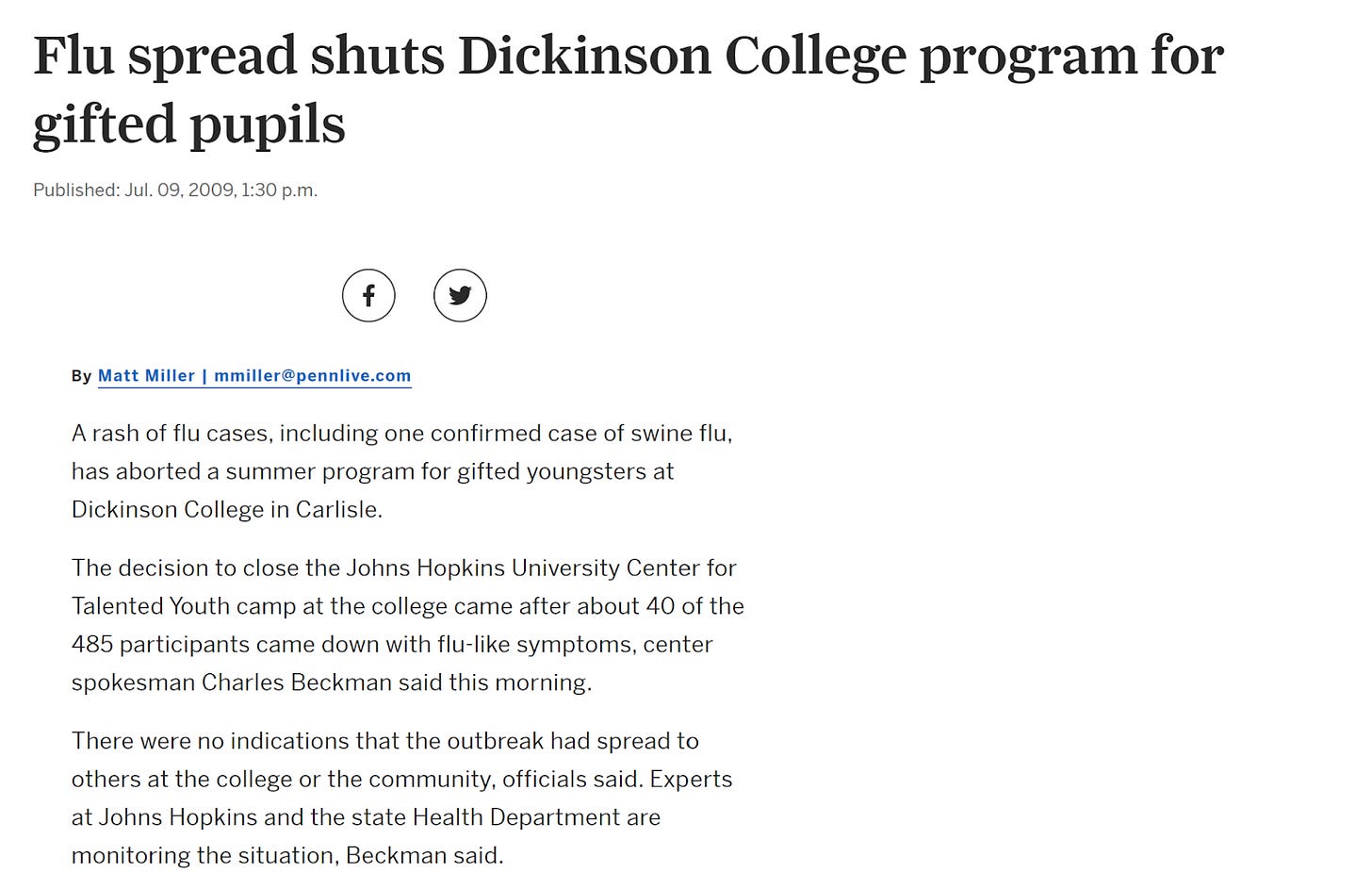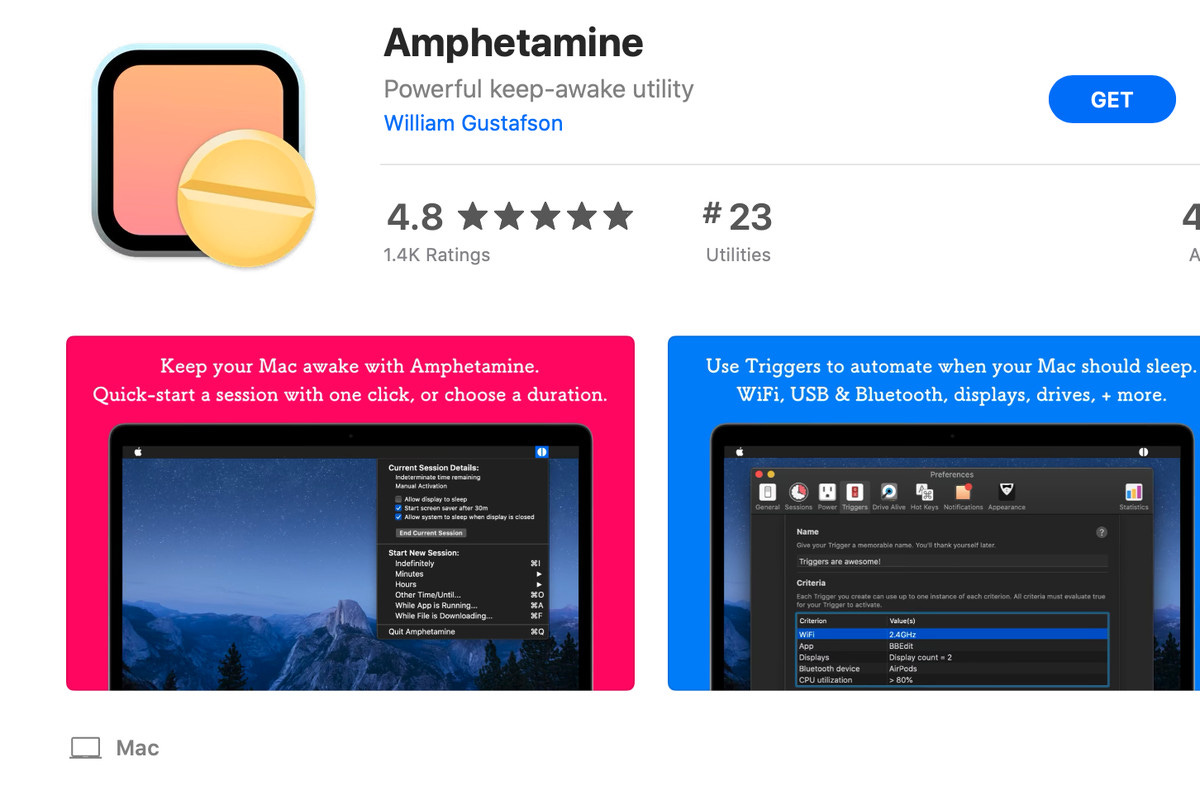When I was 16, a summer camp I was at was shut down due to a swine flu outbreak. The spread happened rapidly, in the way that highly contagious airborne viruses do. First, one confirmed case. They got sent to the nurse’s office then sent home. The next day, a couple more. Nurse’s office, home. Then a few more to the nurse’s office, and a few more (nurse’s office), until there wasn’t room in the nurse’s office anymore. At that point the camp officials realized they had an outbreak on their hands.
On our final day of camp, they called all our parents to pick us up. They had given up on testing us, and just sort of let us be. We were aware at the time that we all probably had swine flu, and that we were going to spread it to our hometowns when our parents picked us up, but nobody had a better idea of what to do. The idea of quarantine wasn’t really a thing yet. I got picked up by my uncle because my parents were on vacation, so I got to spread it to his family and hometown instead. Sorry, Strasbourg.

The thing I remember most about my last day at camp (besides a brief romantic interlude with a girl I was sweet on) was how absolutely fatigued I was. I didn’t feel sick, exactly: I didn’t have a fever, sore throat, or anything like that. I just couldn’t keep my eyes open for longer than an hour at a time. This lasted for about a day or two, and then I recovered.
I thought of this a couple weeks ago, when I caught COVID for the third time (presumably the Omicron BA.5 variant). As I had with swine flu, I spent an entire day sleeping on my first day of symptoms. The days following I slept less and less, until finally I got back to my normal sleep schedule of 8-9 hours at night, and a 30 minute nap in the middle of the day [1].
Thanks for reading my newsletter! Subscribe for free to receive new posts on an every-once-in-a-while basis, mostly about biology.✓
It seemed strange to me that both swine flu and COVID would make me sleep so much. It also seemed strange that I could sleep so much: I’d sleep for 10 hours, do 30 minutes of work, and then be so tired that I’d sleep for another hour on my couch. Whatever made me not need to sleep after getting a lot of sleep normally wasn’t really functioning.
When I started to look into the scientific details, though, I found myself getting stymied. There was no good mechanical/pathophysiological explanation for the fatigue caused by infectious diseases. In fact, there were few good explanations of the sleep patterns in normal people, either [2]. So, I decided to piece together what I could in this post.
What models there are focus around adenosine. Now, adenosine is a complicated molecule. It’s one of the building blocks of RNA, the main carrier of energy in the body (in the form of adenosine triphosphate, or ATP), and a big signaling molecule (in the form of cyclic adenosine monophosphate, or cAMP). It does a lot, so it might seem strange to focus on adenosine and sleep, specifically.
The reason why people have focused so much on adenosine as it relates to sleep, however, is that caffeine blocks adenosine receptors in the brain, which seems to be the cause of its effects on wakefulness. Now, this isn’t the only way to look at sleep, given that lots of things cause wakefulness and don’t have any obvious impact on adenosine, like amphetamine. However, this is a consistent way to cause wakefulness, and the relationship between blocking adenosine receptors and preventing sleep does seem to be pretty robust.

However, once we do start to look at this relationship, we quickly run into some paradoxes. First, administration of adenosine itself doesn’t seem to cause sleepiness, although this may just be an issue of administration to the body not causing a rise in concentration in the brain. More importantly, however, high levels of adenosine deaminase, which breaks down adenosine and which we see in diseases like infectious mononucleosis, does cause fatigue. That’s the opposite of what we’d expect: if blocking adenosine from reaching its receptors causes wakefulness, destroying adenosine before it reaches its receptors should do the same thing.
So, in order to make sense of this relationship, it’s probably useful to start making some distinctions. Specifically, we need to make a distinction between tiredness and fatigue, which I’ve already started using above. Tiredness is what you feel at 1 am in the morning. Fatigue is what you feel after a long run. There’s a definite overlap, given that both can make you sleep. But I think we can all agree they’re not the same thing.
This then allows us to look back at caffeine and adenosine. Caffeine mostly has an effect on tiredness. Drinking a bunch of espresso at 1 am will allow you to pull an all-nighter, but drinking a bunch of espresso halfway through a marathon will not allow you to finish the marathon [3]. Adenosine, as a purely signaling molecule, also mostly has an effect on tiredness. However, adenosine in the body is produced by the breakdown of ATP, and so destroying adenosine can have an effect on the ATP balance as well. Depletion of ATP, the energy carrier, can lead to fatigue.
Keeping all that in mind, we can now examine why exactly swine flu and COVID can make us so tired. It has to do with the immune system.
The immune system is a rapid-response system. Let’s say you get a puncture wound in your hand, introducing a bunch of bacteria into your bloodstream. Your immune system will react incredibly quickly to that, sending a bunch of resources to staunch the bleeding and fight off the invaders. All of that requires energy and signaling, which means all of that requires adenosine triphosphate, or ATP. And, in fact, that works in the reverse, too. ATP also serves as a signal to recruit inflammatory molecules.
But, if ATP is both recruited by and can recruit inflammatory molecules, then that’s a positively-reinforcing cycle. Cool, but how does it end? Well, that’s where adenosine comes in. Solo adenosine serves as an anti-inflammatory, going against the effects of the ATP cycle. Given that solo adenosine is produced by breaking down ATP, we can see how this control system might work. If you need to ramp up the inflammatory response, the balance of ATP and adenosine needs to shift in favor of ATP. If you need to tamp down the inflammatory response, the balance needs to shift in favor of adenosine.
If we have a continuous infection like infectious mononucleosis, something that can remain latent in B cells throughout an individual’s lifetime, it would make sense that we’d have a sustained, systemic immune response. This means we need to shift in favor of ATP by ramping up our levels of adenosine deaminase, which, as we mentioned, breaks down adenosine in the body. Pretty neat, huh?
We can go further, though.Infectious mononucleosis is caused by the Epstein-Barr virus (EBV). And, as we’ve covered before, infection with EBV causes almost all cases of multiple sclerosis.

Guess what treats multiple sclerosis? Cladribine, which inhibits adenosine deaminase. So cladribine allows a buildup of adenosine, tamping down the autoimmune response that causes multiple sclerosis. And guess what the administration of cladribine is commonly associated with? Tiredness! It’s a neat circle.
Now, let’s take a look at the other side of the distinction: fatigue. Specifically, we can look at chronic fatigue syndrome. This isn’t a very well defined condition, but one of its hallmarks is a fatigue that isn’t relieved by rest. If people with chronic fatigue exercise, then go to sleep, they’ll wake up tired. They still feel like they need more sleep. This sounds pretty similar to our COVID/swine flu example, no?
Using chronic fatigue syndrome as our lens to look into the fatigue/tiredness distinction, we find two interesting things. First, people with chronic fatigue syndrome do not use more caffeine than the average person, which suggests they don’t find it helpful in their condition. This separates them from people with multiple sclerosis related tiredness, who do find caffeine helpful.
Second, there’s a subset of chronic fatigue syndrome patients who seem to have an impaired capacity for muscular ATP synthesis. This would relate them back directly to our idea of fatigue as something that’s ATP related.
So, going back to our initial questions about why swine flu or COVID can make us (well, me) sleep a lot, we can first see it as an ATP issue. ATP is needed for the immune response, which results in the sort of fatigue that neither sleep nor caffeine fixes. Then, if the infection continues (like through long COVID), it may turn into an adenosine-caused tiredness, which is alleviated by sleep and caffeine.
It also presents possibilities of how different forms of chronic tiredness or fatigue can be fixed.
Fatigue related to inadequate amounts of ATP can likely only be fixed by somehow increasing the amount of ATP that can be synthesized (perhaps by increasing the amount of ATP synthase), or decreasing the amount of ATP that’s degraded, although that has its own, immune related issues. Tiredness related to excess adenosine (like narcolepsy, perhaps or perhaps long COVID), can likely be fixed by degrading adenosine, like by increasing the amount of adenosine deaminase.
If we really want to take this in a strange direction, we could also suggest that normal tiredness could also be alleviated by increasing the amount of adenosine deaminase. I believe some biohackers are already trying this. However, given the connections to the immune system, that’s probably a dumb idea. You don’t want to accidentally give yourself an autoimmune disease.
[1] I’m aware I sleep more than normal. This is another mystery about sleep that I have, but I really don’t have good explanations for this one. All I can say is that it’s likely genetic, as my dad also needs to sleep a lot, while my mom doesn’t. But yeah, if I get 7 hours of sleep, I’m pretty useless, especially if I need to do anything strenuous or mentally taxing.
[2] This is probably in part due to the difficulty of examining what exactly is going on in the brain at any moment, and in part due to the difficulty of establishing good models of sleep or fatigue. If you leave animals in a lab to their own devices, they’ll spend a lot of the time sleeping because they’re bored. If you freak them out, they won’t sleep. Either way, it’s difficult to get an exact model of “struggling to stay awake because there’s stuff to do”, even though that’s the real issue in COVID or flu related fatigue.
[3] This relationship can get more complicated if we talk about the effect of, say, an energy drink on a marathoner, but I’m pretty sure that is because of the other parts of an energy drink beyond just the caffeine.